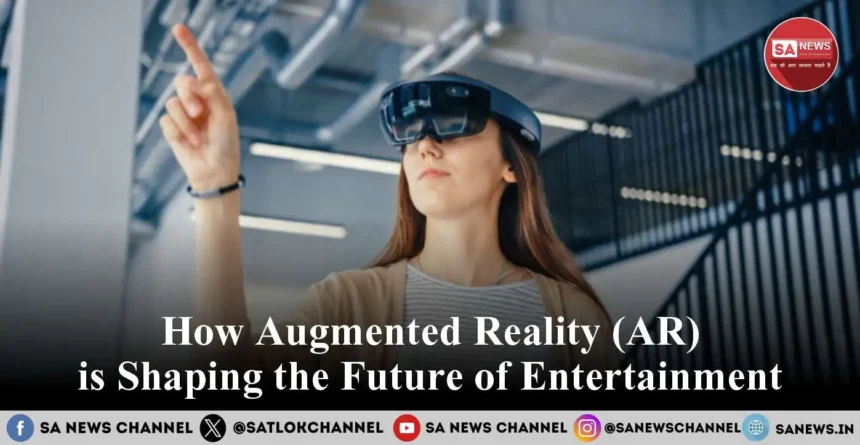AR Technology: Imagine a world where digital information seamlessly blends with physical reality, enhancing our perceptions and how we interact with our surroundings. This isn’t a scene from a futuristic sci-fi movie—this is the revolutionary technology of augmented reality (AR) that is rapidly changing industries and changing our daily lives.
- AR Technology: Understand Augmented Reality Through Different Steps
- How AR differs from VR
- Applications of AR Technology
- AR Technology and Devices
- AR Technology: Benefits of Augmented Reality
- AR Technology: Improved Efficiency in Various Industries
- Challenges and Limitations of AR Technology
- Future of Augmented Reality
- Advancements in AR Displays
- Conclusion
- Beyond Technology: Augmenting Our Spiritual Reality
- FAQs
- 1. What does the abbreviation AR stand for?
- 2. What is AR, and how is it different from Virtual Reality (VR)?
- 3. What are the different applications of AR?
- 4. What devices support AR?
- 5. Is it necessary to download a particular application for viewing AR?
- 6. Is it wise to use AR?
- 7. Can AR work offline?
- 8. In what contexts is AR applied in education, and how?
- 9. What are the limitations of AR?
- Connect With Us on the Following Social Media Platforms
From educational tools that bring textbooks to life to sophisticated healthcare systems that support surgeons during complex surgeries, AR is pushing the boundaries of what’s possible. But this cutting-edge technology presents challenges and questions about its impact on society. How will AR change the way we work, learn and communicate? What potential errors should we consider?
In this blog post, we’ll delve deeper into the world of augmented reality, exploring its basic concepts, various applications and the technology that drives its development. Let’s explore the benefits of AR in various industries and discuss the obstacles it faces. Finally, we will look into the mirror ball and imagine the future of this revolutionary technology. Get ready to explore an exciting place where digital and physical realities meet!
AR Technology: Understand Augmented Reality Through Different Steps
- Definition and core concepts
Augmented Reality (AR) is a technology that superimposes digital information into the real world, augmenting our perception and capability to interact with our physical surroundings. AR adds digital elements to a live view, often by using the camera on a smartphone.
Most of these Augmented Reality (AR) systems share a few basic parts:
1. Real-world environment
2. Digital content
3. Detection/crawling System
4. Hardware and software processing
5. Display devices
Usually AR systems attach to cameras, sensors and sophisticated algorithms in the case of identifying as well as tracking your surroundings. This information is then leveraged to render and place virtual objects within the real-world space accurately in real-time, making for a seamless coexistence of physical as well as augmented reality.
- Brief history and evolution of Augmented Reality (AR)
The concept of AR (AR Technology) has evolved significantly since its inception:
| Year | Milestone |
| 1968 | Ivan Sutherland invents the first head-mounted display system |
| 1990 | Tom Caudell coins the name “Augmented Reality” |
| 1992 | Louis Rosenberg first functional non-harmful augmented reality system |
| 2000 | ARToolKit, an open-source for developing AR applications, is released |
| 2009 | Mobile AR apps hits the consumer market |
| 2016 | “Pokémon GO” goes global interval, showcasing AR’s potential |
| 2019 | Google brings AR features in Google Maps |
Like any form of technology, AR has evolved over time to become more sophisticated and easier for developers to implement. The widespread availability of modern smartphones and tablets have turned them into potent AR platforms making the technology democratized.
How AR differs from VR
While both AR and Virtual Reality (VR) aim to enhance our digital experiences, they differ in several key aspects:
- Environment: AR is the live, direct or real-world view supplemented with computer-generated imagery; whereas, VR provides a completely computer-generated environment.
- Immersion level: AR enables the users to be aware of the real-world environment while engaging in an activity while VR covers the users up with a digital environment.
- Hardware requirements: AR can be seen in gadgets that are easily accessible such as smartphones while VR needs special headsets to be used.
- Applications: AR is best used in expanding actual practice work and communications whereas VR is best used in providing entirely new game, training, and operational simulation experiences.
- User interaction: AR allows an operation of the actual objectl while VR only allows interaction of the virtual world.
It is important that developers and users should understand these differences due to an impact of the selection on the development of future projects.
■ Also Read: Big Data, Big Impact: How Big Data Analytics is Solving Real-World Problems
AR Technology: It can be said that technology finds its relevance in certain areas and uses only. As we proceed with the discussion of the different applications of Augmented Reality, it will become clearer how these attributes make AR exactly what it needs to be to revolutionize different fields and elements of our lives.
Applications of AR Technology
As we delve deeper into the world of Augmented Reality (AR), it’s crucial to explore its diverse applications across various industries. AR technology has found its way into numerous sectors, revolutionizing processes and enhancing user experiences.
- Manufacturing and Industrial Use
In the manufacturing sector, AR has become a game-changer. It enables workers to visualize complex assembly processes, reducing errors and improving efficiency. For instance, AR-powered smart glasses can display step-by-step instructions, allowing technicians to perform maintenance tasks with greater accuracy.
| AR Application | Benefits in Manufacturing |
| Assembly Guidance | Reduces errors, improves productivity |
| Quality Control | Enhances defect detection |
| Remote Assistance | Enables expert support from anywhere |
| Training | Accelerates skill acquisition |
- Retail and E-commerce
Specifically, AR is disrupting the current shopping experience starting with online shopping and moving towards brick-and-mortar stores. Retailers have incorporated AR by way of facilitating try on sessions virtually whereby a customer is placed in a position to see how the product would look like on him/her. This technology has found its use most useful in the furniture and fashion industry.
- Healthcare and Medicine
AR has seen widespread Adoption in the medical field for a variety of uses including pre-operational planning, patient awareness and education amongst others. Doctors are also able to subscribe certain data on the surgical area using Augmented Reality thereby enhancing accuracy and minimizing the risks associated with the practice. Some level of benefits can also be gained by the medical students by using augmented reality anatomical models for study purposes with real feel.
- Education and Training
AR is revolutionizing the way we learn and train. Interactive AR textbooks bring subjects to life, making learning more engaging and memorable. In professional training, AR simulations provide hands-on experience without the associated risks or costs of real-world scenarios.
- Gaming and Entertainment
Perhaps the most visible application of AR is in the gaming and entertainment industry. Games like Pokémon Go have demonstrated the mass appeal of AR-enhanced experiences. Beyond gaming, AR is being used in live events, museums, and theme parks to create immersive and interactive experiences for visitors.
| Industry | AR Application Examples |
| Gaming | Interactive mobile games, AR-enhanced board games |
| Live Events | AR-powered stage effects, interactive concert experiences |
| Museums | AR guides, interactive exhibits |
| Theme Parks | AR-enhanced rides, interactive queues |
As we can see, AR applications span a wide range of industries, each leveraging the technology’s unique capabilities to solve problems and create new opportunities. With ongoing advancements in AR technology, we can expect to see even more innovative applications emerge in the near future.
AR Technology and Devices
AR technology has evolved rapidly, with various devices and platforms emerging to deliver immersive experiences. Let’s explore the primary AR technologies and devices that are shaping the augmented reality landscape.
Vehicle Heads-Up Displays
Vehicle heads-up displays (HUDs) are revolutionizing the driving experience by projecting essential information directly onto the windshield. This technology allows drivers to access crucial data without taking their eyes off the road, enhancing safety and convenience.
Key features of vehicle HUDs include:
| Feature | Description | Benefit |
| Speed display | Shows current speed | Reduces need to look at dashboard |
| Navigation | Turn-by-turn directions | Minimizes distraction from mobile devices |
| Safety alerts | Collision warnings, lane departure | Improves reaction time to potential hazards |
| Vehicle status | Fuel level, engine temperature | Keeps driver informed without instrument panel checks |
AR Technology: Projector-Based AR
Projector-based AR systems use advanced projection technology to overlay digital information onto physical surfaces. This technology is particularly useful in industrial settings, retail environments, and educational institutions.
Applications of projector-based AR include:
- Interactive product displays in retail stores
- Augmented workspaces in manufacturing facilities
- Enhanced learning environments in classrooms and museums
Smart Glasses and Headsets
AR Technology: Smart glasses and AR headsets represent the cutting edge of wearable AR technology. These devices offer hands-free augmented reality experiences, making them ideal for professional and consumer applications.
Popular AR smart glasses and headsets include:
- Microsoft HoloLens
- Magic Leap One
- Google Glass Enterprise Edition
- Vuzix Blade
These devices typically feature:
- High-resolution display
- Advanced sensors for spatial awareness
- Onboard processing capabilities
- voice and gesture controls
Smartphones and Tablets
AR Technology: Smartphones and tablets have become the most accessible platforms for AR experiences due to their widespread adoption and powerful hardware. These devices leverage their built-in cameras, sensors, and processing power to deliver AR applications to a broad audience.
Key advantages of mobile AR include:
| Advantage | Description |
| Accessibility | Most users already own compatible devices |
| Portability | Easy to use AR on-the-go |
| App ecosystem | Large selection of AR apps available |
| Frequent updates | Regular software and hardware improvements |
Popular AR frameworks for mobile devices include Apple’s ARKit for iOS and Google’s ARCore for Android, enabling developers to create sophisticated AR applications for smartphones and tablets.
As AR technology continues to advance, we can expect to see further integration of these devices and platforms, creating more seamless and immersive augmented reality experiences across various industries and everyday life.
AR Technology: Benefits of Augmented Reality
Enhanced User Experiences
Augmented Reality (AR) revolutionizes the way users interact with their environment, offering immersive and engaging experiences across various domains. By overlaying digital information onto the real world, AR enhances perception and provides context-rich interactions. This technology enables users to visualize complex data, products, or concepts in three-dimensional space, making information more accessible and intuitive.
Increased Engagement and Interactivity
AR fosters a new level of engagement by transforming passive consumption into active participation. Users can interact with virtual objects in real-time, manipulating and exploring them in ways previously impossible. This heightened interactivity leads to:
| Benefit | Description |
| Deeper Understanding | Users can examine objects from multiple angles, improving comprehension |
| Memorable Experiences | Interactive elements create lasting impressions |
| Personalization | Content can be tailored to individual preferences and needs |
| Social Sharing | AR experiences can be easily shared, fostering community engagement |
Cost Savings in Training and Maintenance
Implementing AR in training and maintenance processes can significantly reduce costs across industries. By providing virtual guidance and real-time information, AR minimizes the need for physical resources and expert presence. This results in:
- Decreased downtime in maintenance procedures
- Lower risk of errors during complex operations
- Efficient knowledge transfer and skill development
- Reduce travel expenses for trainers and technician
AR Technology: Improved Efficiency in Various Industries
AR’s versatility allows for improved efficiency across multiple sectors:
- Manufacturing: AR-guided assembly lines enhance productivity and reduce error rates.
- Healthcare: Surgeons can visualize patient data during procedures, improving accuracy.
- Retail: Virtual try-ons and product visualizations streamline the shopping experience.
- Education: Interactive AR content makes learning more engaging and effective.
By providing real-time information and guidance, AR reduces the time and effort required to complete tasks, leading to increased productivity and improved outcomes. This technology bridges the gap between digital information and physical reality, enabling workers to make informed decisions quickly and accurately.
■ Also Read: The Future of IT: How Cloud Computing is Reshaping the Digital Landscape?
As AR continues to evolve, its benefits are expected to expand, driving innovation and transforming industries. The enhanced user experiences, increased engagement, cost savings, and improved efficiency offered by AR are just the beginning of its potential to reshape how we interact with the world around us.
Challenges and Limitations of AR Technology
As augmented reality (AR) continues to evolve and gain traction, it faces several significant hurdles that must be addressed for widespread adoption. This section explores the key challenges and limitations currently affecting AR technology.
- Content creation complexities
Creating high-quality AR content requires a unique skill set and specialized tools. Developers face numerous challenges when designing AR experiences:
● 3D modeling and animation expertise
● Integration of real-world data with virtual elements
● Ensuring seamless interaction between virtual objects and the physical environment
These complexities often result in longer development cycles and higher production costs, limiting the availability of AR content.
- User adoption barriers
Despite the potential of AR, several factors hinder its widespread adoption:
| Barrier | Description |
| Learning curve | Users may find AR interfaces unintuitive or difficult to navigate |
| Social acceptance | Wearing AR devices in public spaces may cause discomfort or self-consciousness |
| Cost | High-end AR devices remain expensive for many consumers |
| Limited content | Lack of diverse, engaging AR applications reduces user interest |
Overcoming these barriers is crucial for AR to gain mainstream acceptance and become a part of everyday life.
- Privacy and security concerns
As AR technology collects and processes vast amounts of data about users and their surroundings, privacy and security issues become paramount:
● Unauthorized access to personal information
● Potential for AR devices to be hacked or compromised
● Concerns about constant surveillance in public spaces
● Data storage and protection challenges
Addressing these concerns is essential to build trust and ensure the responsible development of AR technology.
- Hardware constraints
Current AR hardware faces several limitations that impact user experience and functionality:
● Battery life: Most AR devices have limited battery capacity, restricting usage time
● Processing power: Complex AR applications require significant computational resources
● Display technology: Achieving high-resolution, wide field-of-view displays remains challenging
● Form factor: Bulky designs can be uncomfortable for extended use
AR Technology: Overcoming these hardware constraints is crucial for creating more seamless and immersive AR experiences.
As the AR industry works to address these challenges and limitations, the technology continues to advance. The next section will explore the exciting possibilities and potential developments in the future of augmented reality.
Future of Augmented Reality
As augmented reality (AR) technology continues to evolve, its potential to reshape various aspects of our lives becomes increasingly apparent. The future of AR holds promise for significant societal impacts, expansion into new industries, advancements in display technology, and seamless integration with other emerging technologies.
Potential Societal Impacts
AR is poised to transform how we interact with the world around us, influencing various aspects of society:
- Education: AR will revolutionize learning experiences, allowing students to visualize complex concepts and engage with interactive 3D models.
- Healthcare: Medical professionals will benefit from AR-assisted surgeries and enhanced diagnostic tools, improving patient outcomes.
- Urban Planning: Cities will leverage AR for better design and management of public spaces, enhancing the quality of life for residents.
- Social Interaction: AR will introduce new ways for people to connect and communicate, potentially altering social norms and behaviors.
Expansion into New Industries
While AR has already made inroads in gaming and retail, its application is set to expand into numerous other sectors:
| Industry | Potential AR Applications |
| Manufacturing | Real-time quality control and assembly guidance |
| Tourism | Interactive guided tours and historical reconstructions |
| Real Estate | Virtual property viewings and architectural visualizations |
| Agriculture | Crop monitoring and precision farming techniques |
| Automotive | Enhanced navigation systems and heads-up displays |
Advancements in AR Displays
The potential future of AR displays seems to feature enhancements improving user interactions & access:
- Smart glasses with light weight and high definition
- AR Contact Lens Displays
- RealityGround — Mediated Reality Experiences with Shared AR Views
- AR interactions controlled by thoughts using brain-computer interfaces
- These advances will make AR more engaging and intuitive as well as a more integrated part of our lives.
As these technologies fuse, we have to look forward to the time when Augmented Reality will be unnoticeable and will be a part of our daily technological environment as we have smartphones today. As to the trends in the usage of augmented reality, they create numerous opportunities for improvement of human capabilities, facilitation decision making as well as opening new perspectives for innovation in practically all spheres of society.
AR Technology: Augmented Reality (AR) has become one of the most trending technologies in recent years that has developed as a new way of expanding the perception of the real world through its digital overlay. Starting with its principles to its versatility of uses in various settings, AR has the capability to change the way that we conduct business, educate ourselves, socialize, and be entertained. Integration of digital information on top of real-life scenes, together with further enhancements in AR devices, has put the technology to more opportunities for further development and application.
Conclusion
As beneficial as AR is for numerous domains, it does come with a specific number of drawbacks including, privacy issues, technology issues, and last but not least the issues that refer to the adoption of said technology. So, as these challenges are gradually being solved and progress is made, AR is destined to become more and more influential in determining the future.
It therefore becomes pertinent for organizations and persons of interest to be aware of advancements in AR technology and seek to apply this technology as a competitive tool in their line of businesses.
Beyond Technology: Augmenting Our Spiritual Reality
As we marvel at augmented reality’s ability to enhance our physical world, let’s not forget the importance of augmenting our spiritual reality. While AR overlays digital information on our surroundings, spiritual wisdom can overlay meaning and purpose onto our lives. Books like “Gyan Ganga” and “Way of Living” by Saint Rampal Ji Maharaj offer profound insights into life’s true purpose and ethical living. These teachings encourage us to look beyond the material world and explore our inner selves. By balancing technological advancements with spiritual growth, we can truly augment our entire existence, leading to a more fulfilling and purposeful life.
FAQs
1. What does the abbreviation AR stand for?
Ans. Augmented Reality (AR) is an application that delivers digital information layers consisting of images, sounds, or information onto the live camera-streamed scenes observed by smartphones, AR glasses, or tablets.
2. What is AR, and how is it different from Virtual Reality (VR)?
Ans. AR overlays virtual images onto the existing reality and makes the environment interactive, while VR renders the real physical environment and replaces it with a virtual one.
3. What are the different applications of AR?
Ans. AR is applied in gaming, education, shopping processes such as trying on clothes, navigation, industry—especially in the processing and maintenance of large equipment—and in simulation.
4. What devices support AR?
Ans. AR can be used on smartphones, tablets, AR glasses, and specific AR headsets like Microsoft HoloLens.
5. Is it necessary to download a particular application for viewing AR?
Ans. Yes, you normally require an app that supports augmented reality. A web-based AR experience is also slowly becoming popular.
6. Is it wise to use AR?
Ans. While AR can be useful, it may lead to some incidents since the user might be distracted by what the tool presents to them.
7. Can AR work offline?
Ans. While some AR applications require an internet connection, others can work offline if the content is downloaded initially.
8. In what contexts is AR applied in education, and how?
Ans. AR in education makes learning easier because, instead of referring to hardcopy books, students can use books in animation form containing 3D models, animated lessons, and virtual lessons.
9. What are the limitations of AR?
Ans. AR experiences can be limited by the device’s camera, processing speed, battery capacity, or the amount of RAM. Also, developing high-quality AR content can be quite costly.









